This post originally appeared on the “Better Questions” email list. If you’d like to get one email like this a week, please sign up at BetterQuestionsEmail.com. Thanks!
—-
Hi ,
Last week, we covered the Goal Tree – a tool designed to help us explicitly define what we want.
But things don’t usually go the way we want. What do we do, then?
The next step in the Logical Thinking Process, the Current Reality Tree, is all about defining our problems.
Before we can do that, however, let’s talk about problems a little bit.
Problems And Undesirable Effects
Problems come in all shapes and sizes. They can be personal or interpersonal, societal or internal, within our control or without.
Because of this variety, it can be hard to get a handle on what our problems really are, or if we can do anything about it.
The Thinking Process approaches this by first getting rid of the word “problems” altogether – too much baggage, too many different meanings.
Instead of problems, the LTP talks about “undesirable effects.”
An “undesirable effect” is any deviation from your critical success factors, as determined by your Goal Tree. In essence, this means that an undesirable effect is just one way in which current reality differs from your ideal reality.
There’s a couple key points here I want to highlight:
For one, defining undesirable effects as deviations from our goal tree means that undesirable effects aren’t subjective. They have nothing to do with what we should want, or what other people say is best for us.
We built the goal tree, and the goal tree is what determines our undesirable effects. So in a very real way, we choose our undesirable effects in the process of choosing our goals. Ultimately, all of this is within our control.
Secondly, undesirable effects is a useful term in that it focuses our attention on the system that produced the effect, rather than some kind of permanent trait we possess.
One of my favorite things about the LTP is that it depersonalizes the problems in our lives. We’re not blaming anyone; instead, we’re focusing on the chain of events that result in the undesirable effect. This makes difficult problems easier to address, especially when they involve other people.
Why We Build The Current Reality Tree
The Current Reality Tree is all about defining “the gap” between where we are and where we want to be.
We figure out our undesirable effects – the places where reality objectively – differs from what was in our Goal Tree – and then we break those down into root causes that produce a majority of our issues.
You may be thinking, “Well, that’s all well and good, but I already KNOW what my problems are.” And you may be right!
But truly understanding the nature of our undesirable effects is harder than you might think.
Remember: reality is complex. Because effects may sometimes be far removed in time or space from the original causes, it’s often quite difficult to understand the underlying reasons our undesirable effects exist in the first place.
This leads us to waste time addressing the wrong things. It’s a bit like a doctor treating the symptoms, but not the disease – while we may feel a bit better in the short term, our underlying condition will remain until we do something about it.
The Current Reality Tree helps us get beneath the surface level and down to the disease. It allows us to make rapid progress in a very short amount of time….because we often find that one or two critical root causes are actually producing the majority of our undesirable effects!
That’s the appeal of the Current Reality Tree in a nutshell:
It allows to make massive improvement with a minimum amount of effort by focusing our efforts on the few things that really, really matter.
With that out of the way, let’s talk about creating our own Current Reality Tree!
Step By Step: Building the Current Reality Tree
Step One: Determine Your Undesirable Effects
The Current Reality Tree is going to look and act a lot like the Goal Tree – but instead of our goal at the top, we’re going to have some Undesirable Effects.
You can have as many Undesirable Effects (UDEs, or “ooh-dees”) as you like, but usually we’ll start with somewhere between 1 and 3. The more UDEs you include, the more complex the tree and the longer it’ll take!
How do we find our Undesirable Effects? Look at your Goal Tree. Remember the Critical Success Factors – the layer just below our ultimate goal? This is where we start. Which of these is NOT a reality right now? Where are we falling short, and how?
In my example, I’ll start with Critical Success Factor “Reduce Stress” from my Goal Tree.
(If you recall, “Reduce Stress” was a Critical Success Factor of my Goal to “Massively Improve My Quality of Life In 2021.”)
I’m going with my gut here, but I certainly feel stressed lately, which is a good indication that I have an Undesirable Effect here. One UDE will be enough for me right now.
Once you’ve picked out your UDEs, write them out as a complete sentence. Be specific about what’s going on, but try not to include any potential reasons or connected ideas – we just want to make our current situation and how it differs from the Critical Success Factor explicit.
I wrote: “I feel significant amounts of ‘bad stress’ related to my work.” That’s my Undesirable Effect.
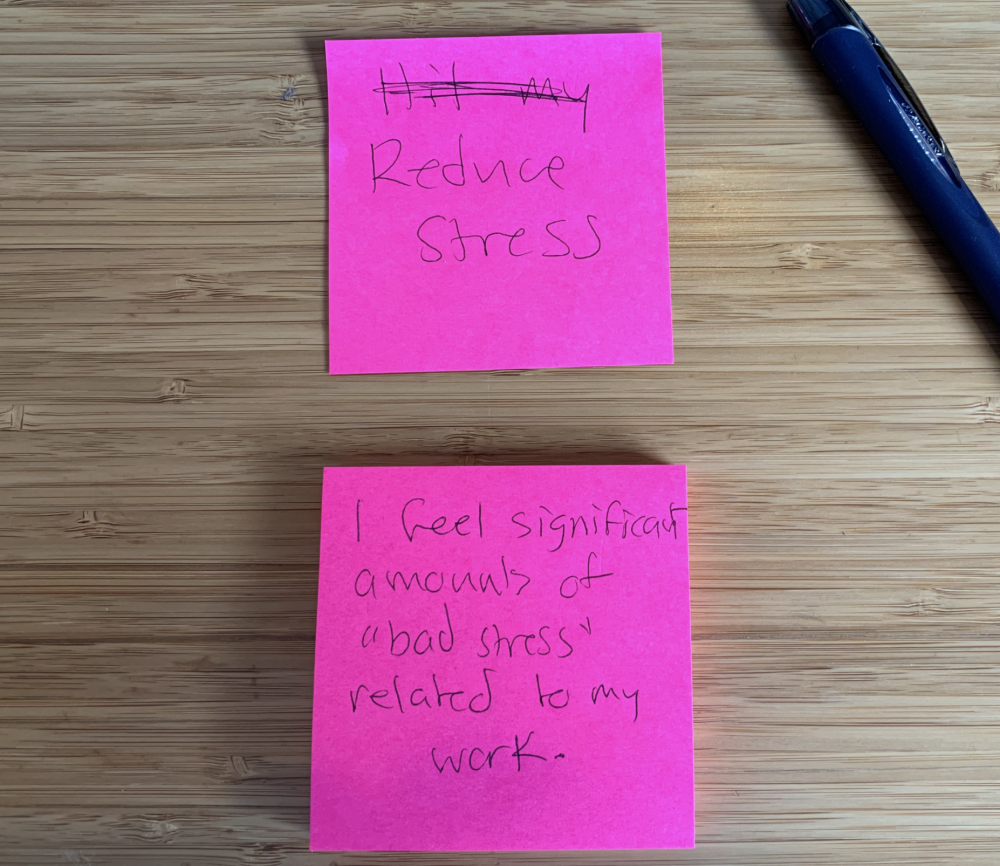
Step Two: Determine 2-3 Layers of Causality.
To kick things off, I’m going to try and dig down 2-3 layers of causality for each Undesirable Effect I chose.
To do this, ask yourself “Why?” Why does this undesirable effect exist?
While this may seem simple, be careful here. What we want to do is make our logic “tight” – that means not skipping any steps in the chain of causality.
For example, let’s say we were breaking down the UDE “Molly and I rarely hang out.”
I wouldn’t want to skip straight to “She has to work.” Lots of people with plenty of time to hang out also have to work. So what’s really going on here?
By adding in the intermediate steps we initially jumped over, the chain of causation becomes much clearer:
“Molly and I rarely hang out.”
Why?
“Molly isn’t available to hang out when I call her.”
Why?
“Molly only has free time on Tuesday nights.”
Why?
“Molly has to work every other night of the week.”
Why?
“Molly has bills that she needs to pay, and her job doesn’t pay her much…”
This chain paints a very different picture than our first one!
This careful attempt to list out all the logically necessary steps in a chain may seem like a pain in the butt, and I won’t lie – it can be difficult. But it’s also incredibly valuable.
The reason that so many of our problems in life seem intractable or impossible to solve is exactly because we often skip over so many determining factors when we analyze the problem. Every single intermediate step in a chain provides us an opportunity to break it – and thus, to solve previously “unsolvable” problems.
For now, just focus on getting 2-3 layers of causation down the sequence – but try and make sure not to skip any intermediate steps.
Also, keep in mind that one entry on your tree might have multiple contributing factors. Look at my first attempts at this step as an example:
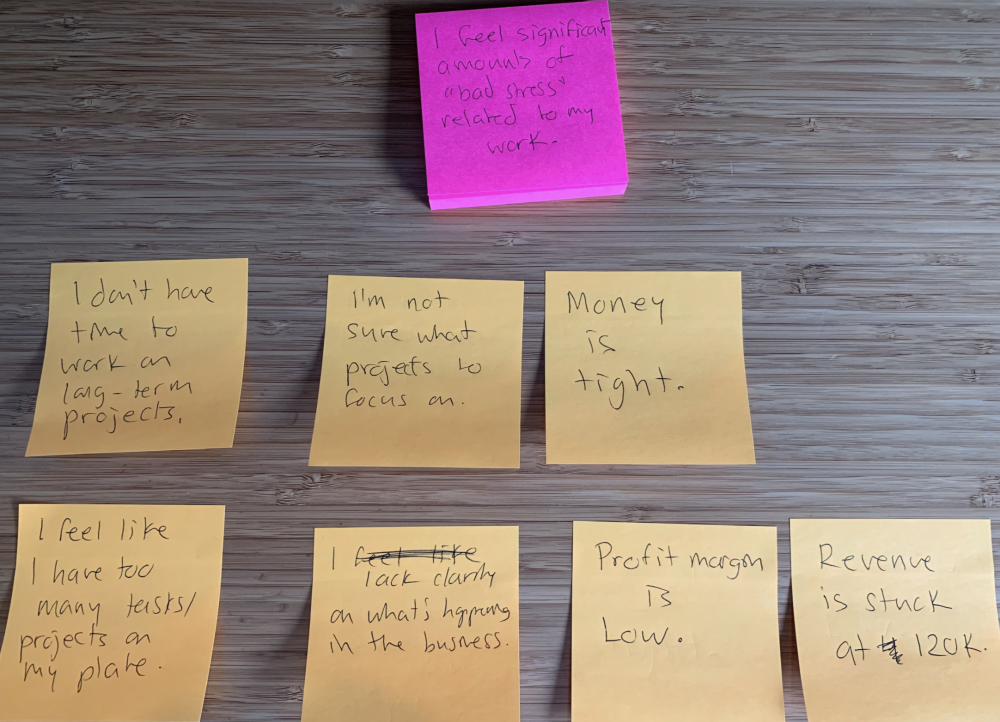
One of the causes of my UDE is “Money is Tight.” That makes sense – when money is tight, paying bills can be difficult and my stress levels go up.
My first attempt at digging deeper into the causation of “Money is Tight” was “Revenue is stuck at 120k,” which also makes sense. After all, if we made more money, money wouldn’t be so tight…right?
While that reasoning is correct, after some thought I realized that revenue alone wasn’t sufficient to cause “Money Is Tight.” After all, even if my revenue stayed at 120k, if I kept all that money I wouldn’t have any money problems at all!
No – revenue by itself isn’t sufficient. “Money is Tight” has to be caused by a combination of “Revenue being stuck at 120k” AND “Profit margin being low.” Neither one of these can cause this UDE on their own…they’re BOTH necessary for the problem to occur.
Feel free to break up your UDEs into a many contributing factors as is necessary. Don’t worry if you don’t get them all right away – building an accurate Current Reality Tree will take some time and thought, and you’ll be revising all along the way.
Step Three: Build our your initial structure.
Once we’ve got our first few layers of causation down, it’s time to start building our the structure of the tree.
I prefer to hang my notes on a whiteboard, but you could do it on a wall, on a big piece of paper, on your desk, or in a notebook.
If you can, pick a surface you can draw safely on.
Put your Undesirable Effects at the very top, then arrange your notes in order below. Group “like” effects and causes together. Don’t worry too much about getting the structure right yet – you’ll be adding to this tree quite a bit, and moving things around is perfectly normal.
Here, you can see my initial notes stuck onto the whiteboard in roughly the right order:
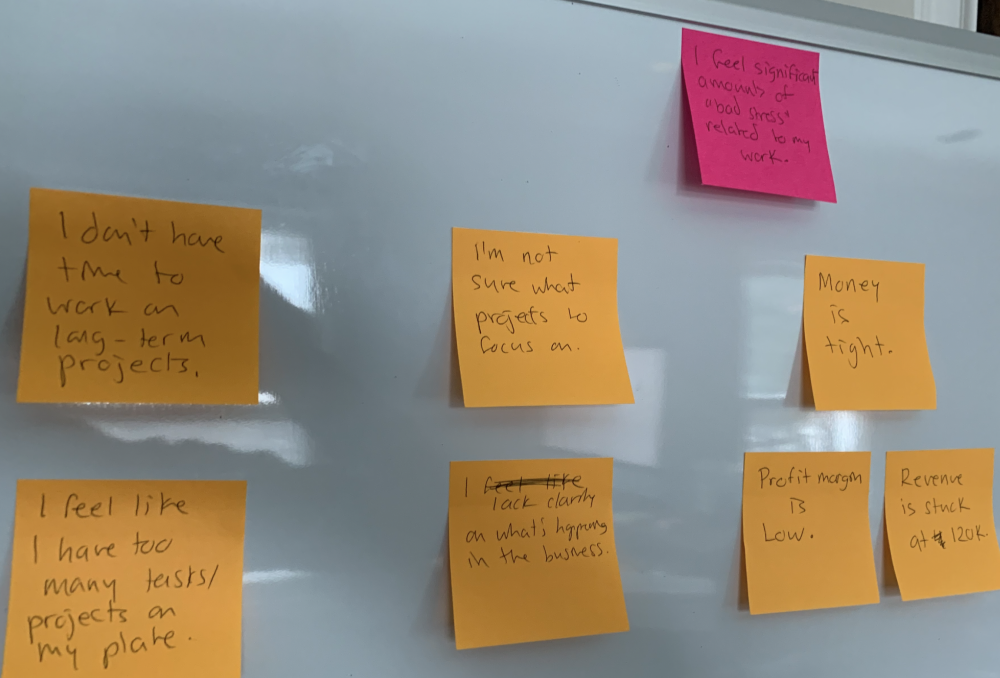
Step Four: Improve The Logic Of The Clusters.
It’s strange how often a simple change in perspective can shift how we see things.
Now that your notes are hung up, do you see any way to improve the logic of your tree?
- Is the meaning of each statement clear?
- Are there any “compound ideas” – statements that contain an if-then relationship? If so, break them up into separate entities.
- Are there any intermediate steps missing?
- Are the causes enough, by themselves, to result in the effect? Are we missing anything?
Step Five: Build your cause and effect chains downward.
Pick one of the clusters you’ve created and start digging deeper into it’s chain of causation.
For each Post-It, ask yourself: “Why does this exist?”
The answers to that question become your next row of notes…and so on, until you find you can’t dig any further.
A quick word on this: theoretically, you should be able to follow ANY Undesirable Effect all the way down it’s chain of causation to the Big Bang and the formation of the universe. After all, that’s where all this started!
But knowing all that isn’t really going to help us much. So: when do we stop digging down through our chains of causation?
A good rule of thumb is to stop digging when you start to reach things that are out of your span of control or sphere of influence.
Let’s examine these two concepts for a moment, because they’re really important.
Your span of control is all the stuff that you have direct control over. If you decide to change it, you can change it. Your diet is within your span of control, while your genes are not.
Your sphere of influence is all the stuff that you can influence, but need to work with other people in order to truly change. For example, while you may not have control over the policies at work, you have influence over them: you could build a plan to change them, gather support from your coworkers and lobby your boss.
If the UDE you’re addressing is personal, you might stop digging when you hit a cause that is outside your span of control. If you’re building a Current Reality Tree for use within your company, you might stop when you hit causes that are outside your sphere of influence.
This is probably going to be the most time-consuming part of this process. It’ll take a while to work through your various branches…and you’ll want to stop, take stock and ensure you’re not skipping over any intermediate steps as you go. Sometimes you get this done in a single session, sometimes it takes multiple sessions.
Repeat this process until you get to the lowest level of causation within your span of control or sphere of influence for each branch…and then, move on to the next step.
Here’s my Current Reality Tree, built out about as far as I could take it:
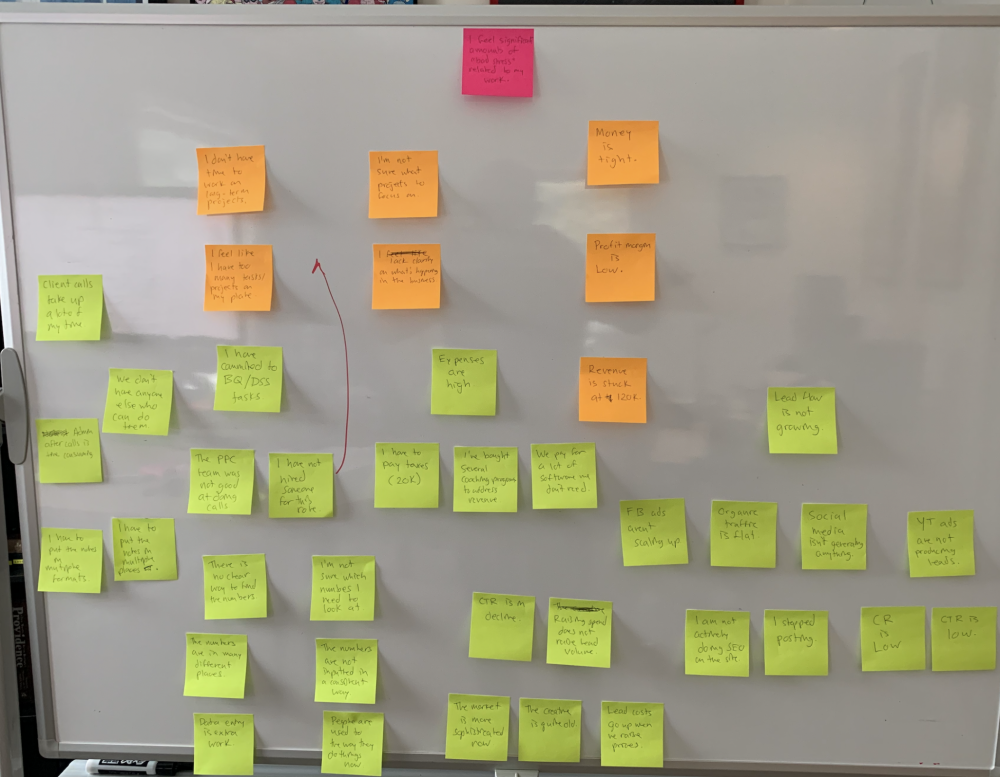
Step Six: Connect Your Entities With Arrows of Causation.
Once you’ve got enough pieces to work with, start connecting them with arrows to show their cause and effect relationships.
The arrows should flow upwards, culminating in the Undesirable Effect at the top.
We can visually express different kinds of relationships with different types of arrows:
- One plain arrow flowing into a given effect means that a single cause produced that effect.
- Multiple plain arrows flowing into a single effect means that multiple causes are contributing to that effect.
- Multiple arrows flowing into a single effect, joined by an oval, means that all causes are required to produce the effect.
For example, to produce a fire we need wood and a source of ignition. Without either one, that fire isn’t getting lit. If we were to diagram this out, “Lit Fire” would be at the top. “Wood” and “Source of ignition” would be on the layer below it, each with an arrow pointing upwards towards “Lit Fire.” We would then circle both arrows at their tips to show that they are both necessary.
This is a great time to look for two important elements: lateral connections and negative reinforcing loops.
Lateral Connections are connections between different branches of our tree. Do any causes in one cluster lead to effects in another? Are there any obvious places where the “branches” of your tree intersect? Finding these connecting nodes is important, because they provide useful places to focus when we’re looking for solutions that will solve multiple issues at once.
Negative reinforcing loops are causes and effects that feedback on one another, sending us into a “death spiral” of ever-worsening results. An example might be “I’m extremely hungry” and “I don’t want to cook.” Let’s examine that a bit.
“I’m extremely hungry…so…”
“I don’t have any energy…so…”
“I don’t feel like cooking…so…”
“I don’t have any food to eat…so…”
“I’m extremely hungry.”
Each element of the loop feeds into the next, making it very hard to break out of.
While our example here is a little silly, negative reinforcing loops are EXTREMELY damaging, and are often hiding in plain sight. Finding one in your tree provides a high-leverage point of change – break the loop and massive change will follow.
Whenever you spot a negative reinforcing loop on your tree, make sure to mark it somehow. I like using blue marker for my regular causal arrows and red marker for my negative loops, since it stands out. However you mark them, keep an eye out for negative reinforcing loops of any kind!
Here’s my tree, with causal arrows added:
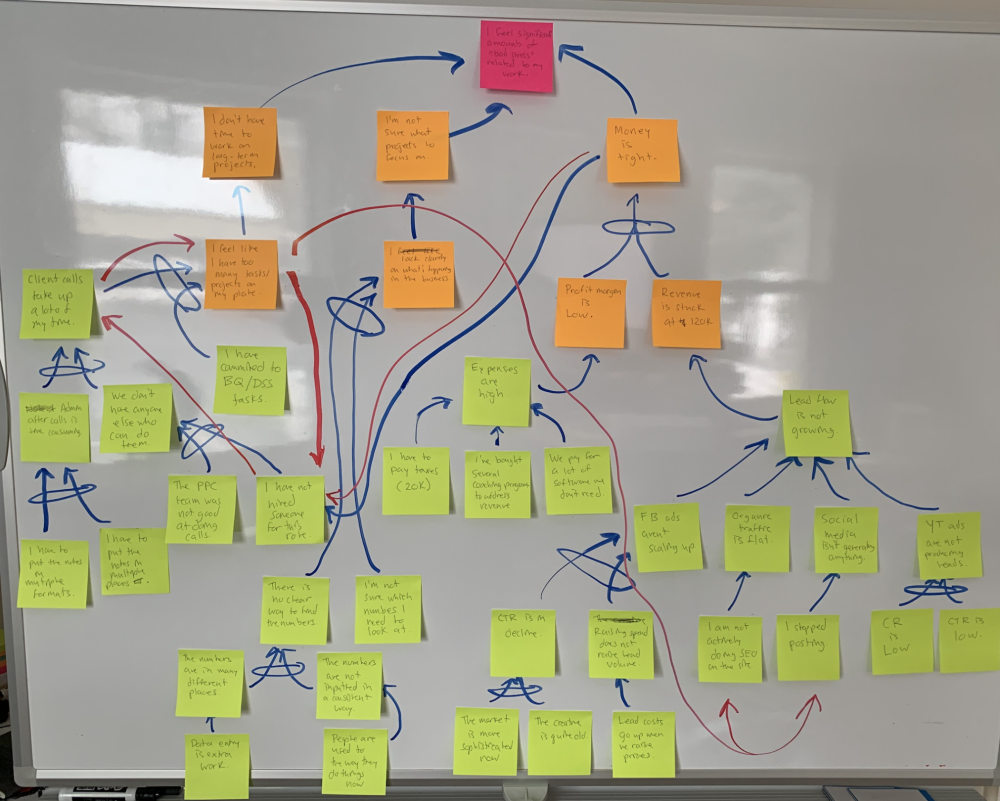
Step Seven: Scrutinize the entire tree.
Take a step back (literally!) and take in the entire tree.
Much like the Goal Tree, one of the strengths of these tools is that extremely complex and abstract problems are made visible. Seeing something physically manifested can often bring out insights you wouldn’t have otherwise been aware of.
Feel free to spend time sitting with and thinking about your tree. Sometimes additional causes will occur to you that will force you to reorganize or re-think parts of your tree. That’s great!
Our goal here isn’t speed – it’s clarity. Working to keep our thought process clear and logical will ensure that when we move on to the final step in the process we get the absolute best results possible.
That brings us to….
Step Eight: Identify Which Critical Root Causes To Attack.
Here we are – the culmination of the entire Current Reality Tree:
Identifying the highest-leverage Root Causes to work on.
Remember that Critical Root Causes are the lowest levels of causation on our tree that are within our span of control or sphere of influence. They are the deep roots of our surface-level Undesirable Effects.
Scanning your tree will often reveal that only a handful of Critical Root Causes are producing most of your Undesirable Effects, especially if Negative Reinforcing Loops are involved. These are obvious places to focus.
You might also ask yourself which of your Critical Root causes have the most potential for improvement. Are any easier to address than others? Are there any you KNOW how to fix, or any that you’re confident you can get rid of? All of these might factor into your decision of what to work on.
In my example, the Current Reality Tree revealed single Critical Root Cause that was behind nearly ALL of my Undesirable Effects! Negative Reinforcing Loops were causing greater and greater problems across multiple branches of my tree…even ones that seemed unrelated.
I dig into my specific tree, what I found there, and how I identified my most important Critical Root Cause in this video:
Summing It All Up
There’s no getting around it – building out a complete Current Reality Tree can take a lot of work, especially if you started off with a bunch of Undesirable Effects.
But it’s an illuminating and highly valuable experience.
So often, we attempt to solve problems that we’re profoundly unclear on…and that can lead to wasted effort, frustration, and painfully slow progress.
Getting clear on not just our Undesirable Effects, but the most effective ways to deal with them can be the key to solving the “unsolvable…”
And doing it in record time.
However, just diagnosing the gap isn’t enough…
Now, we have to figure out how to close that gap.
Next week, we begin that process with perhaps the most famous Logical Thinking Process tool:
The Evaporating Cloud.
See you then!
- Dan

Leave a Reply